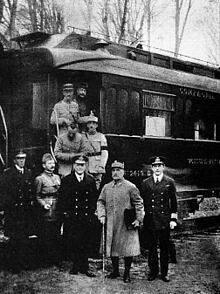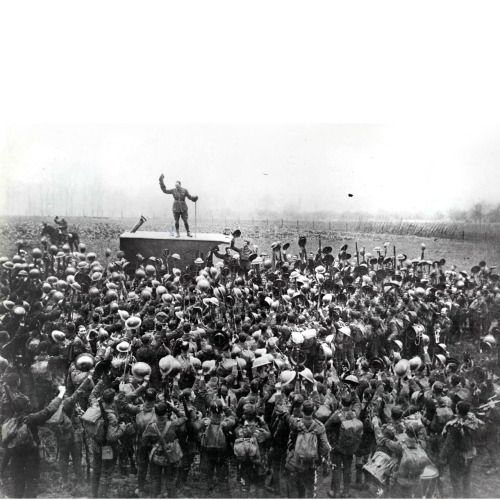The Hammond Circus Train Wreck kills 86 near Hammond, Indiana.
Tag Archives: 1918
11 November 1918
Germany signs an armistice agreement with the Allies in a railroad car in the forest of Compiègne to end WWI.
The Armistice of 11 November 1918 was an armistice during the First World War between the Allies and Germany – also known as the Armistice of Compiègne after the location in which it was signed – and the agreement that ended the fighting on the Western Front. It went into effect at 11 a.m. Paris time on 11 November 1918 (“the eleventh hour of the eleventh day of the eleventh month”), and marked a victory for the Allies and a complete defeat for Germany, although not formally a surrender.
The Germans were responding to the policies proposed by U.S. President Woodrow Wilson in his Fourteen Points of January 1918. The actual terms, largely written by French Marshal and Supreme Commander of the Allied Armies Ferdinand Foch, included the cessation of hostilities, the withdrawal of German troops to behind their own borders, the preservation of infrastructure, the exchange of prisoners, a promise of reparations, the disposition of German warships and submarines, and conditions for prolonging or terminating the armistice. Although the armistice ended the actual fighting, it took six months of negotiations at the Paris Peace Conference to conclude the peace treaty, the Treaty of Versailles.
21 February 1918
The last surviving Carolina parakeet dies in captivity at the Cincinnati Zoo.
The Carolina Parakeet was the only parrot species native to the eastern United States. It was found from southern New York and Wisconsin to the Gulf of Mexico, and lived in old forests along rivers. It is the only species classified in the genus Conuropsis. It was called head of yellow or pot pot chee by the Seminole and kelinky in Chickasaw.
The last known wild specimen was killed in Okeechobee County, Florida, in 1904, and the last captive bird died at the Cincinnati Zoo on February 21, 1918. This was the male specimen, called “Incas”, who died within a year of his mate, “Lady Jane”. Coincidentally, Incas died in the same aviary cage in which the last Passenger Pigeon, “Martha”, had died nearly four years earlier. It was not until 1939, however, that it was determined that the Carolina Parakeet had become extinct. Some theorists at this time, though, believed a few may have been smuggled out of the country in mid 20th century and may have repopulated elsewhere, although the odds of this are extremely low.
At some date between 1937 and 1955, three parakeets resembling this species were sighted and filmed in the Okefenokee Swamp of Georgia. However, the American Ornithologists’ Union analyzed the film and concluded that they had probably filmed feral parakeets. Additional reports of the bird were made in Okeechobee County, Florida, until the late 1920s, but these are not supported by specimens.
The Carolina Parakeet is believed to have died out because of a number of different threats. To make space for more agricultural land, large areas of forest were cut down, taking away its habitat. The bird’s colorful feathers were in demand as decorations in ladies’ hats. The birds were also kept as pets and could be bred easily in captivity. However, little was done by owners to increase the population of tamed birds. Finally, they were killed in large numbers because farmers considered them a pest, although many farmers valued them for controlling invasive cockleburs. It has also been hypothesized that the introduced honeybee helped contribute to its extinction by taking many of the bird’s nesting sites.
11 November 1918
Germany signs an armistice agreement with the Allies in Compiègne to end fighting on the Western front during World War I.
The last day of World War One was November 11th 1918, known as Armistice Day. Despite November 11th being the last day of the war, on many parts of the Western Front fighting continued as normal. This meant, of course, that casualties occurred even as the people of Paris, London and New York were celebrating the end of the fighting.
This was done at 05.10am on November 11th. However, the actual ceasefire would not start until 11.00 to allow the information to travel to the many parts of the Western Front. Technology allowed the news to go to capital cities by 05.40 and celebrations began before very many soldiers knew about the Armistice. In London, Big Ben was rung for the first time since the start of the war in August 1914. In Paris, gas lamps were lit for the first time in four years. But on the Western Front, many tens of thousands of soldiers assumed that it was just another day in the war and officers ordered their men into combat. Officially over 10,000 men were killed, wounded or went missing on November 11th 1918. The Americans alone suffered over 3,000 casualties.
21 July 1918
A U156 submarine shells Nauset Beach, in Orleans, Massachusetts.
12 October 1918
In Carlton County, Minnesota a forest fire kills 453 people.
17 July 1918
The Shooting of the Romanov royal family.
14 December 1918
The President of Portugal, Sidónio Pais, is assassinated.
31 March 1918
Daylight saving time starts in the United States for the first time.
24 February 1918
Estonia declares independence.



